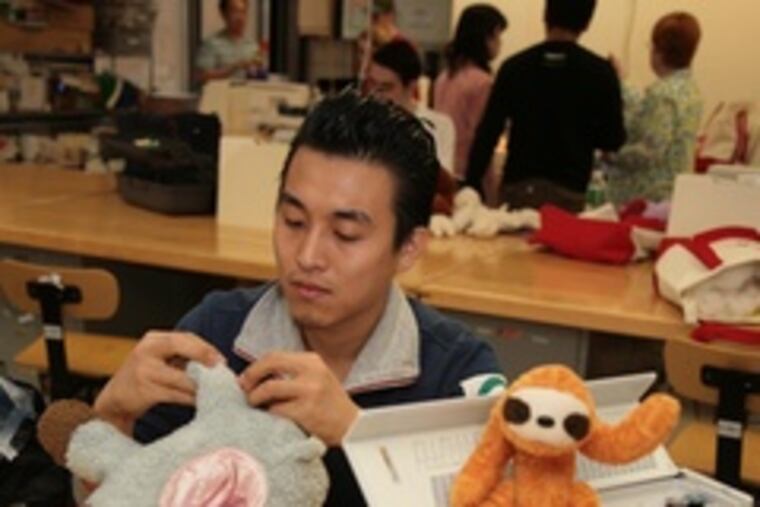In college, designing cool new playthings
With her classmates looking on, Laura Mansdorf pushed around a plastic turtle on wheels. The turtle's shell had been replaced by an ice cream maker that spun around as the turtle moved, mixing ice with rock salt, cream with vanilla.

With her classmates looking on, Laura Mansdorf pushed around a plastic turtle on wheels. The turtle's shell had been replaced by an ice cream maker that spun around as the turtle moved, mixing ice with rock salt, cream with vanilla.
No crazy inventor she. Mansdorf was presenting her Twirlie Turtle, a creation that would help her complete the requirements for a bachelor's degree in toy design from the Fashion Institute of Technology (FIT) in New York.
"The day of the presentation, I didn't have time to make the ice cream," she says. "I was just praying the turtle would turn the heavy ball at all."
Since graduating last year, Mansdorf, 25, has designed three CSI Activity Kits, two of which have made it onto the shelves of Toys R Us.
"Sometimes, I'll just think of how cool it is that I get to create products for other people to enjoy," she says.
It's a far cry from Santa's workshop, but toy design has become a highly competitive field. Two colleges offer degrees in it, and schools ranging from Massachusetts Institute of Technology to Savannah College of Art and Design in Georgia to Columbia College in Chicago have added toy design to their industrial design and arts programs.
With the recent massive recalls of toys made in China and Mexico, would-be toy designers from the United States, whose skills are already much in demand, might soon be entertaining even more job offers.
"We have a 99 percent success rate for placing students in the industry after graduation," says Judy Ellis, who runs the toy-design department at FIT, which started in 1986 as a research project sponsored by Mattel. It was turned into a full undergraduate program in 1989.
Ellis, who used to teach graphic design at Parsons School of Design in New York, says FIT students have gone on to work for some of the world's biggest toy companies and inventors groups, such as Mattel Fisher-Price Brands, Lego, and Disney. And the school's graduates have designed some of the more popular toys of the last decade, including Tickle Me Elmo and the WWE Bash and Brawl Wrestlers.
Otis College of Art and Design in Los Angeles offers the only other major in toy design, according to the Toy Industry Association.
Every one of last year's class members got jobs, says Deborah Ryan, department chair at Otis. In fact, a 2003 Otis graduate helped design the iZ, an animatronic MP3 player that was nominated as the most innovative toy of 2006 by the toy association.
"Now, if you graduate with a degree in industrial design, you have to compete with people who are much more experienced in toy design," Ryan says. What helps, she adds, is that the experience at Otis goes beyond manufacturing.
Now in its 10th year, the program also teaches courses in child psychology, package design and game theory, as well as offering classes with names such as "Juvenile Anatomy" and "Ergonomics and Toy Industry Practices." Ryan, who worked for Mattel and Disney in the 1980s on such classics as My Little Pony, said these are things you don't get with industrial design or engineering degrees.
MIT introduced toy design in 2004, with the launch of the Toy Design Lab, funded by Hasbro. It's a place for graduate students to do research into toy design and engineering, whose success led MIT to offer, in 2005, a for-credit course called "Toy Product Design" for undergraduate students of mechanical engineering. Fifteen students were in the first class; 27 enrolled in 2007.
To date, only one toy from MIT's Toy Design Lab, the Nerf Atom Blaster, has made it onto shelves. The project started when Hasbro asked MIT to find a way to make a Nerf toy that could shoot projectiles farther than anything else on the market.
Dave Mendez, 28, a sculptor and illustrator who lives in New York, is currently working on his application to get into FIT's toy-design program.
"While I was making sculptures, I realized that I wanted to learn the process of making action figures," he says. His sculptures and drawings run the gamut from an illustration of a duck with a pompadour to a one-eyed purple squid with five tentacles made of clay.
"Some of the characters are childlike, but some are not," he says. "But with everything I was making, I felt like toy design is what I was meant to do."